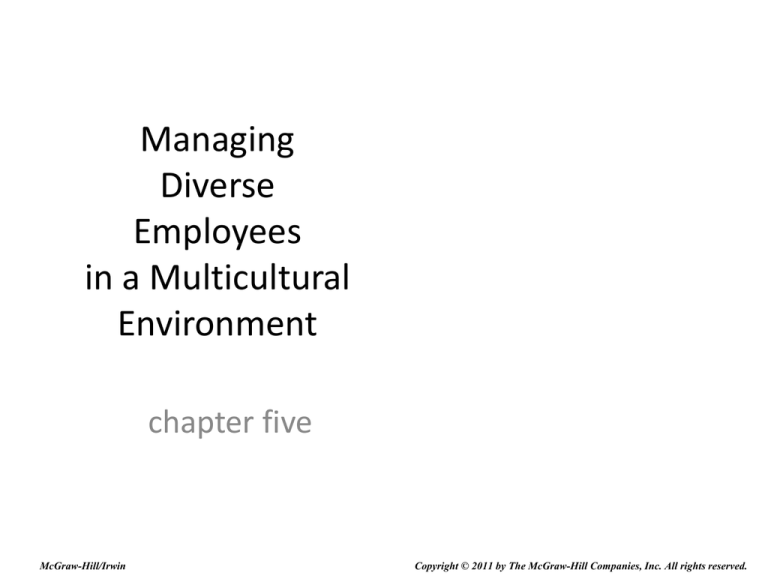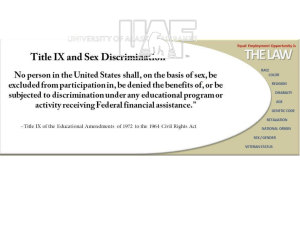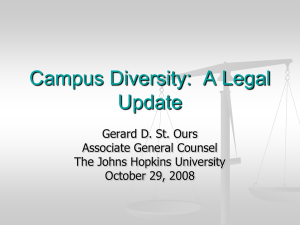
Managing
Diverse
Employees
in a Multicultural
Environment
chapter five
McGraw-Hill/Irwin
Copyright © 2011 by The McGraw-Hill Companies, Inc. All rights reserved.
Learning Objectives
1. Discuss the increasing diversity of the workforce and of the
organizational environment.
2. Explain the central role that managers play in the effective
management of diversity.
3. Explain why the effective management of diversity is both an
ethical and a business imperative.
4. Discuss how perception and the use of schemas can result in
unfair treatment.
5. List the steps managers can take to effectively manage
diversity
6. Identify the two major forms of sexual harassment and how
they can be eliminated.
5-2
The Increasing Diversity of the
Workforce and the Environment
• Diversity
– Dissimilarities/differences among people in age,
gender, race, ethnicity, religion, sexual orientation,
socioeconomic background, and
capabilities/disabilities, and any other
characteristic used to distinguish between people
5-3
Sources of Diversity in the Workplace
Figure 5.1
page 172
5-4
The Increasing Diversity of the
Workforce and the Environment
• Glass ceiling
– alludes to the invisible
barriers that prevents
minorities and women
from being promoted
to top corporate
positions
5-5
Workforce Diversity: Age
• Aging U.S. Population
–Median age in the United States is 36.2 years, by
2030 20% of the population will be over 65
• Federal Age Discrimination Laws
–1964 Title VII of the Civil Rights Act of 1964
–1967 Age Discrimination in Employment Act
5-6
Major EEO Laws
Insert Table 5.1
5-7
Workforce Diversity: Gender
• Women in the Work Place
– U.S. workforce is 46.5% percent female
– Women’s median weekly earnings are $638
compared to $798 for men
– Women hold only 15.4% of corporate officer
positions
5-8
Race and Ethnicity
• The U. S. Census Bureau distinguishes between 20+
races
• The racial and ethnic diversity of the U.S. population
is increasing at an exponential rate, as is the
composition of the workforce
• Ethnicity refers to groupings of people based on a
shared characteristic such as national origin,
language or culture. So an ethnicity is whether a
person is Hispanic, Latino, or of Spanish origin or not.
– The Census Bureau treats ‘ethnicity’ in terms of
whether a person is Hispanic or not Hispanic
5-9
Workforce Diversity: Religion
• Accommodation for Religious Beliefs
– Scheduling of critical meetings
– Providing flexible time off for holy days
– Posting holy days for different religions on the
company calendar
5-10
Workforce Diversity: Capabilities and
Disabilities
• Disability Issues
– Providing reasonable accommodations for
individuals with disabilities
– Promoting a nondiscriminatory workplace
environment
– Educating the organization
about disabilities and AIDS
5-11
Example - Google
• International users account for more than 50%
of Google’s total user base
• In May 2007, Google started their 40
Language Initiative with the goal of getting
Google products into 40 languages.
12
Workforce Diversity:
Socioeconomic Background
• Socioeconomic background
– refers to a combination of social class and incomerelated factors
• Socioeconomic diversity
– requires that managers be sensitive and responsive to
the needs and concerns of individuals who might not
be as well off as others, provide them with
opportunities to learn, advance, and make meaningful
contributions to the organization while improving
their economic well-being.
5-13
Workforce Diversity: Sexual
Orientation
• Sexual Orientation Issues
– Employment and workplace discrimination
– Provision of same-sex partner benefits
5-14
Other Kinds of Diversity
• In most cases, physical sources of diversity
have no bearing on their job performance
• However, sometimes these end up influencing
advancement rates and salaries
5-15
Critical Managerial Roles
• Managers can take many more steps to
become sensitive to the ongoing effects of
diversity in their organizations, take advantage
of all the contributions diverse employees can
make, and prevent
diverse employees
from being unfairly
treated.
5-16
Critical Managerial Roles
Insert Table 5.2
5-17
The Ethical Imperative to Manage
Diversity Effectively
• Distributive Justice
– A moral principle calling for fair distribution of pay,
promotions, and other organizational resources
based on meaningful contributions that
individuals have made and not personal
characteristics over which they have no control.
5-18
The Ethical Imperative to Manage
Diversity Effectively
• Procedural Justice
– A moral principle calling for the use of fair
procedures to determine how to distribute
outcomes to
organizational
members.
5-19
Procedural Justice
• Exists when managers:
– carefully appraise a subordinate’s performance
– take into account any environmental obstacles
to high performance
– ignore irrelevant personal characteristics
5-20
Managing Diversity Effectively Makes
Good Business Sense
• What a Diversity of Employees Provides
– A variety of points of view and approaches to
problems and opportunities can improve managerial
decision making.
– Diverse employees can provide a wider range of
creative ideas.
– Diverse employees are more attuned to the needs of
diverse customers.
– Diversity can increase the retention of valued
organizational members.
– Diversity is expected/required by other firms
5-21
Perception
• Perception
– The process through which people select,
organize, and interpret what they see, hear, touch,
smell, and taste to give meaning and order to the
world around them.
5-22
Perception
• Schema
– An abstract knowledge structure stored in
memory that allows people to organize and
interpret information about a person, event, or
situation
• Gender Schema
– Preconceived beliefs or ideas about the nature of
men and women, their traits, attitudes, behaviors,
and preferences
5-23
Perception
• Stereotype
• Bias
– Simplistic and often
inaccurate beliefs about
the typical
characteristics of
particular groups of
people
– The systematic tendency
to use information about
others in ways that
result in inaccurate
perceptions
5-24
Bias
• Similar-to-me effect – perceive others who are
similar to ourselves more positively than we perceive
people who are different
• Social status effect – perceive individuals with high
social status more positively than those with low
social status
• Salience effect – focus attention on individuals who
are conspicuously different
5-25
Overt Discrimination
• Overt Discrimination
– Knowingly and willingly denying diverse
individuals access to opportunities and outcomes
in an organization
– Unethical and illegal
5-26
Steps in Managing Diversity Effectively
•
•
•
•
•
•
Secure top management commitment
Strive to increase the accuracy of perceptions
Increase diversity awareness
Increase diversity skills
Encourage flexibility
Pay close attention to how organizational members
are evaluated
• Consider the numbers
5-27
Steps in Managing Diversity Effectively
(cont.)
• Empower employees to challenge discriminatory
behaviors, actions, and remarks
• Reward employees for effectively managing
diversity
• Provide training utilizing a multi-pronged,
ongoing approach
• Encourage mentoring
of diverse employees
5-28
Diversity Awareness Programs
• Provide members with accurate information about
diversity
• Uncover personal biases and stereotypes
• Assess personal beliefs, attitudes, and values and
learning about other points of view
• Develop an atmosphere in which people feel free to
share their differing perspectives
• Improve understanding of others who are different
5-29
How to Manage Diversity
• Mentoring
– A process by which an experienced member of an
organization provides advice and guidance to an
less experienced member and helps them learn
how to advance in the organization and in their
career.
5-30
Forms of Sexual Harassment
• Quid pro quo
– Asking for or forcing an
employee to perform
sexual favors in
exchange for receiving
some reward or avoiding
negative consequences.
5-31
Forms of Sexual Harassment
• Quid pro quo
– Asking for or forcing an
employee to perform
sexual favors in
exchange for receiving
some reward or avoiding
negative consequences.
5-32
Forms of Sexual Harassment
• Hostile work environment
– Telling lewd jokes, displaying pornography, making
sexually oriented remarks about someone’s
personal appearance, and other sex-related
actions that make the work environment
unpleasant
– Interferes with their ability to perform their jobs
effectively
5-33
Steps to Eradicate Sexual Harassment
• Develop and clearly communicate a sexual
harassment policy endorsed by top
management
• Use a fair complaint procedure to investigate
charges of sexual harassment
5-34
Steps to Eradicate Sexual Harassment
• When it has been determined that sexual
harassment has taken place, take corrective
action as soon as possible
• Provide sexual harassment education and
training to all organizational members,
including managers
5-35
Factors to Keep in Mind About Sexual
Harassment
• Every sexual harassment charge should be
taken seriously
• Employees who go along with unwanted
sexual attention in the workplace can be
victims
• Employees sometimes wait before they file
complaints
5-36
Factors to Keep in Mind About Sexual
Harassment
• A firm’s sexual harassment policy should be
communicated to each new employee and
reviewed with current employees on a
periodic basis
• Suppliers and customers need to be familiar
with a firm’s sexual harassment policy
5-37
Factors to Keep in Mind About Sexual
Harassment
• Managers should give employees alternative
ways to report incidents of sexual harassment
• Employees who report sexual harassment
must have their rights protected
• Allegations of sexual harassment should be
kept confidential
5-38
Factors to Keep in Mind About Sexual
Harassment
• Investigations of harassment charges and any
disciplinary action should proceed in a timely
manner
• Managers must protect employees from
sexual harassment from any third-party
employees
5-39








